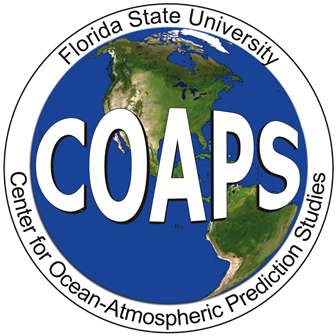Ocean Modeling
Ocean modeling activities within the Center for Ocean-Atmospheric Predictions Studies (COAPS) include model development, research, and graduate instruction, using models of various complexity, architecture, horizontal and vertical coordinate representaion as the principal tools. Models employed at COAPS vary from very high-resolution (hundreds of meters between grid points with very fine vertical grid spacing) regional models to basin-scale and global models.
The models currently used at COAPS are:
Regional/coastal: NCOM, FVCOM, HYCOM, ROMS
Basin-scale: HYCOM
Global: HOPE, HYCOM
Model experiments are routinely run on the local COAPS computers as well as at various supercomputer centers (FSU, NAVOCEANO, NCAR, etc.). Modeling studies focus on a wide range of topics from exploring physical processes in the deep and upper ocean to improving ocean forecasting. Coupling of the ocean models with different atmospheric/flux models allows researchers to study air-sea interaction at a wide range of time scales. For example, regional models coupled to the BVW atmospheric heat flux model are used to perform more realistic analyses of the air-sea interaction and ocean response during hurricanes. The global models are coupled to either the COAPS/FSU global atmospheric model or to the NCAR Community Atmosphere Model (CAM) within the Community CLimate System Model (CCSM). These coupled models are used to investigate climate variability or climate change.
Please contact Steve Morey, Dmitry Dukhovskoy, or Eric Chassignet for more information.
Ocean Prediction
The field of physical oceanography has matured to a point where it is conceivable to combine numerical models and observations via data assimilation in order to provide ocean prediction products on various spatial and time scales (Chassignet and Verron, 2006). As a result, many nations have begun large scale efforts to provide routine products to the oceanographic community. The Global Ocean Data Assimilation Experiment (GODAE) provides a framework for these efforts, i.e., a global system of observations, communications, modeling, and assimilation that will deliver regular, comprehensive information on the state of the oceans, in a way that will promote and engender wide utility and availability of this resource for maximum benefit to the community.
The societal benefits are an increased knowledge of the marine environment and ocean climate, predictive skills for societal, industrial, and commercial benefit and tactical and strategic advantage, as well as the provision of a comprehensive and integrated approach to the oceans. The main scientific benefit, which derives from the development of the above ocean prediction capability, is the better understanding of ocean physical processes and their influences on marine ecosystems.
The Center for Ocean-Atmospheric Prediction Studies (COAPS) is part of a broad partnership of institutions that is presently collaborating in developing and demonstrating the performance and application of eddy-resolving, real-time global and basin-scale ocean prediction systems using the HYbrid Coordinate Ocean Model (HYCOM). This partnership is the eddy-resolving global ocean prediction system development effort that is sponsored by the U.S. component of GODAE.
Contact Eric Chassignet for more information.

